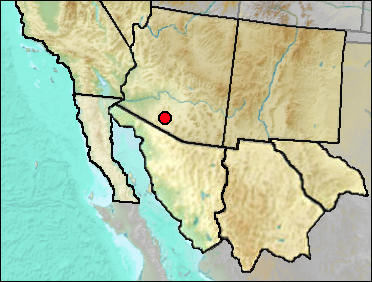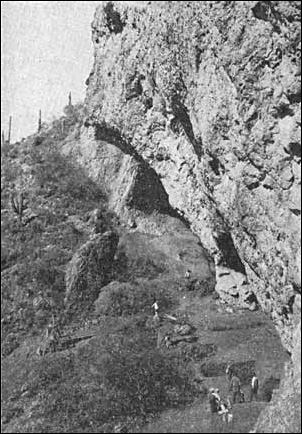 Age. Late Wisconsin. Probable source of
Pleistocene fauna with a date of 12,300 ± 600 BP (Huckell and Vance 2003) for the Conglomerate Layer from which the fossils are thought to have originated. In the preface (1975) to the second printing of Haury (1950), a date of 11,300 ± 1200 was given for the Volcanic Debris Layer.
Age. Late Wisconsin. Probable source of
Pleistocene fauna with a date of 12,300 ± 600 BP (Huckell and Vance 2003) for the Conglomerate Layer from which the fossils are thought to have originated. In the preface (1975) to the second printing of Haury (1950), a date of 11,300 ± 1200 was given for the Volcanic Debris Layer.

Fig. 1. Ventana Cave. Image courtesy of the U.S. National Park Service.
General Description. Huckell and Vance (2003): A rock shelter in the Castle Mountains formed by erosion of poorly consolidated material at the junction with overlying basalt. A spring is present. The pertinent strata are the volcanic debris layer and the underlying agglomerate. The original excavation was in 1941 and the major report by Haury, with others, in 1950.
Ventana Cave became well known for the apparent association of extinct fauna and human-produced artifacts. However, a later series of radiocarbon dates in a block of material left by Haury indicate mixing of the volcanic debris layer, and the current interpretation is that the source of the extinct fauna in that layer is the underlying conglomerate (Huckell and Vance 2003).
Fauna.
†Nothrotheriops shastensis—Shasta Ground Sloth (Colbert 1950)
Callospermophilus lateralis—Golden-mantled Ground Squirrel (Colbert 1950)
Cynomys ludovicianus—Black-tailed Prairie Dog (Colbert 1950)
Neotoma sp.—Woodrats (Lance 1959)
Lepus californicus—Black-tailed Jackrabbit (Colbert 1950)
†Panthera atrox—American Lion (Colbert 1950)
Felis atrox
†Canis dirus—Dire Wolf (Colbert 1950)
Canis latrans—Coyote (Colbert 1950)
Vulpes macrotis—Kit Fox (Colbert 1950)
Taxidea taxus—American Badger (Colbert 1950)
†Equus occidentalis—Western Horse (Colbert 1950)
†Tapirus merriami—Merriam's Tapir (Colbert 1950)
Tapirus sp.
Pecari sp.—Peccary (Colbert 1950)
Colbert (1950:137): "...it is realized that this tooth may well represent the genus Platygonus, rather than Pecari."
Odocoileus sp.—Odocoiline Deer (Colbert 1950: ?)
Large Cervid. Colbert 1950:138: "...it would seem possible that it represents one of the western deer of the genus Odocoileus." (Colbert 1950)
†Stockoceros conklingi—Conkling's Pronghorn (Colbert 1950: cf.)
Tetrameryx (Stockoceros) cf. conklingi
Bison sp.—Bison (Colbert 1950)
Literature. Colbert 1950.; Haury 1950; Huckell and Haynes 2003
Last Update: 17 Sep 2014